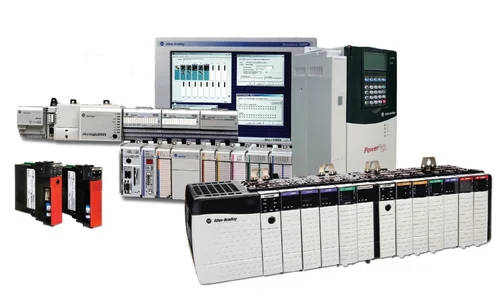
What Does PLC Stand For and How Does It Revolutionize Industrial Automation?
What Does PLC Stand For?
In the world of industrial automation, PLC stands for Programmable Logic Controller. A PLC is a ruggedized, industrial-grade digital computer used to monitor and control electromechanical processes, such as machinery on factory assembly lines, amusement rides, or lighting fixtures.
Before PLCs, automation relied on hard-wired relay logic systems large, complex, and inflexible control panels with thousands of relays and wires. These systems were difficult to troubleshoot and nearly impossible to reprogram without complete rewiring.
This changed dramatically in 1968, when Dick Morley invented the first PLC. By 1973, Modicon introduced the first commercial PLCs, replacing relay logic in manufacturing plants such as General Motors. The result? More compact systems, improved flexibility, and much faster response to process changes.
How PLCs Revolutionized Industrial Automation
PLCs replaced miles of wiring with compact, programmable units that could:
-
Run logic operations without mechanical relays
-
Be easily reprogrammed or reconfigured
-
Offer real-time control and diagnostics
-
Operate in harsh industrial environments (vibration, heat, electrical noise)
Today’s PLCs support both discrete and analog control, perform complex computations, communicate across industrial networks, and provide high reliability with onboard diagnostics, redundant systems, and backup power capabilities.
Core Components of a PLC System
A PLC control system typically includes the following five components:
1. Processor (CPU)
The brain of the PLC, responsible for executing instructions and processing data.
-
Arithmetic & Logic Unit (ALU)
-
Program Memory
-
Timers & Counters
-
Process Image Memory
2. Memory
-
ROM: Stores the firmware and core functions.
-
RAM: Stores the current values from inputs, timers, and counters.
3. Input/Output Modules
These modules connect the PLC to external devices.
-
Input Modules: Gather signals from sensors, switches, etc.
-
Output Modules: Send control signals to actuators, motors, valves, and relays.
4. Power Supply
Converts 120/240V AC to 24V DC for internal logic circuitry. Note: This power supply does not drive field devices.
5. Programming Device
Used to upload or modify logic in the PLC.
-
PCs, handheld programmers, or HMI interfaces
-
Programs are written using PLC-specific software
How Do You Program a PLC?
PLCs are programmed using graphical or text-based languages, standardized under IEC 61131-3.
Graphical Languages:
-
Ladder Diagram (LD) – Resembles electrical schematics (ideal for electricians)
-
Function Block Diagram (FBD) – Logic blocks connected by wires
-
Sequential Function Chart (SFC) – Similar to flowcharts, ideal for sequential processes
Textual Languages:
-
Structured Text (ST) – High-level language similar to Pascal or C (great for complex logic)
-
Instruction List (IL) – Assembly-style, now mostly obsolete
The PLC Scan Cycle
PLCs run in a cyclical process known as the program scan cycle, typically completing within milliseconds.
The 4 Steps:
-
Internal Checks – Self-diagnostics and health checks
-
Input Scan – Read all inputs and update memory
-
Logic Execution – Run user program logic
-
Output Scan – Update outputs based on the logic
What Can a PLC Do?
PLCs are built for real-time industrial control. Their flexibility and reliability make them ideal for tasks such as:
-
Assembly Line Control – Managing complex sequences across multiple stations
-
SCADA/HMI Integration – Serving as the control backbone between equipment and visualization platforms
-
Robotics Coordination – Precise timing and control for automated machinery
-
Data Logging & Monitoring – Real-time performance and fault tracking
-
Remote Access and Predictive Maintenance – Via IIoT and edge computing integration
Applications of PLCs
PLCs are used across virtually every industrial sector:
| Industry | Applications |
|---|---|
| Manufacturing | Automated assembly lines, packaging systems |
| Energy & Utilities | Power grid control, water treatment automation |
| Automotive | Welding robots, testing rigs, part conveyors |
| Food & Beverage | Batch control, pasteurization, bottling, labeling |
| Pharmaceutical | GMP-compliant batch processing, real-time documentation |
| Oil & Gas | Drilling platform automation, pipeline monitoring |
Types of PLCs
Different PLCs cater to different scale and complexity levels:
1. Integrated/Compact PLCs
-
Fixed I/O count
-
Ideal for simple applications (e.g., small machinery)
2. Modular PLCs
-
Stackable modules for I/O, communications, and memory
-
Great for scalable systems and medium-to-large facilities
3. Distributed PLCs
-
Networked across multiple locations
-
Used in complex plants and multi-building operations
Conclusion
The Programmable Logic Controller (PLC) has fundamentally transformed industrial automation. By replacing bulky, inflexible relay systems with software-driven control, PLCs offer unmatched scalability, speed, and efficiency.
From running a single machine to orchestrating thousands of automated operations across plants, PLCs are the beating heart of modern industry. As IIoT, AI, and machine learning become mainstream, the role of the PLC will only grow evolving from control logic processors into smart, networked automation hubs of the future.
Need Help Choosing the Right PLC?
At PLG Automation, we offer expert advice and a full inventory of Allen-Bradley, Siemens, Omron, and other leading brands. Whether you're building a new system or upgrading an old one, we’re here to help.
📧 Email: sales@plgautomation.com
📞 Phone: 800-906-9271
